Charles E W Bean, Diaries, AWM38 3DRL 606/270 PART 1/1 - 1918 - 1939 - Part 9
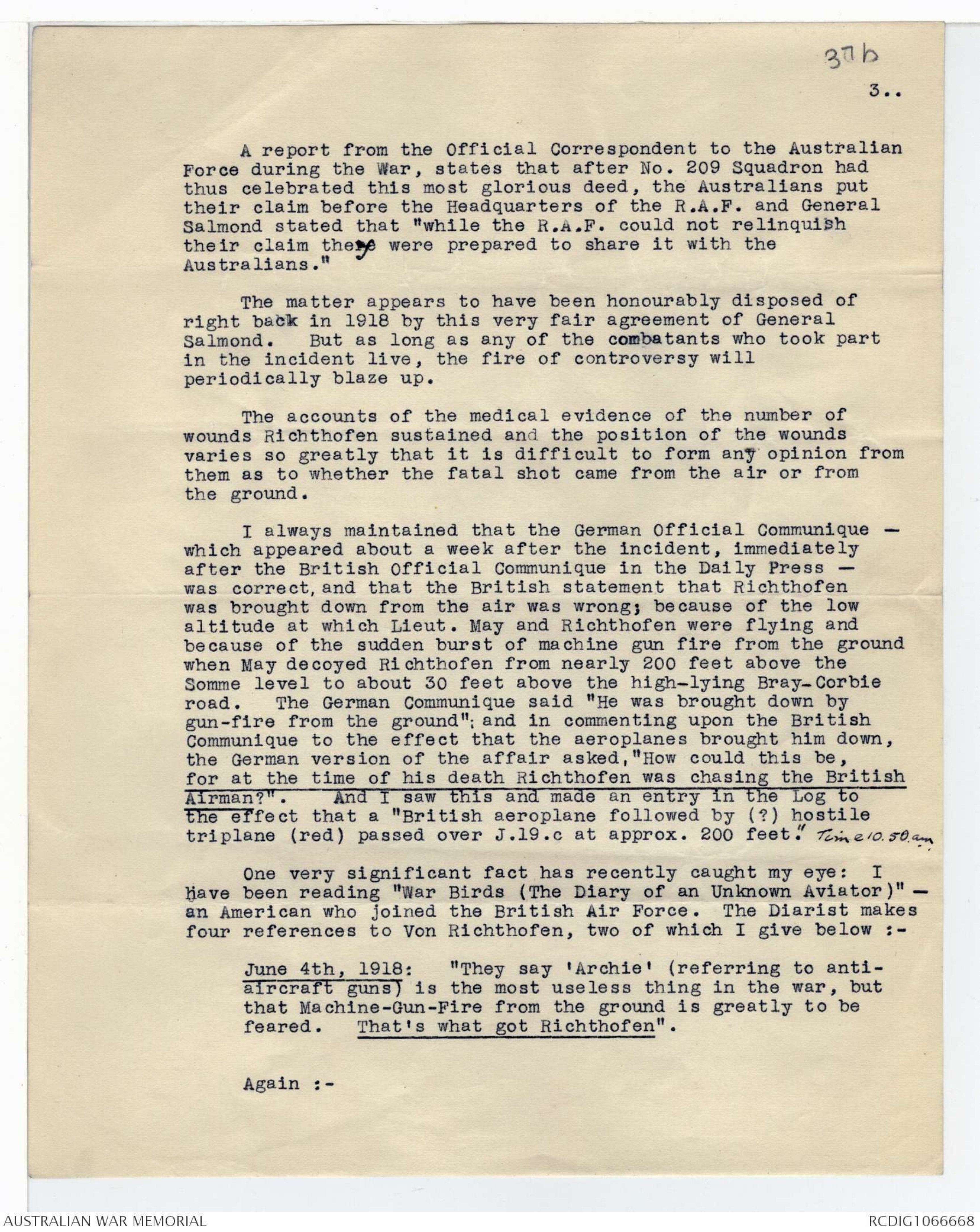




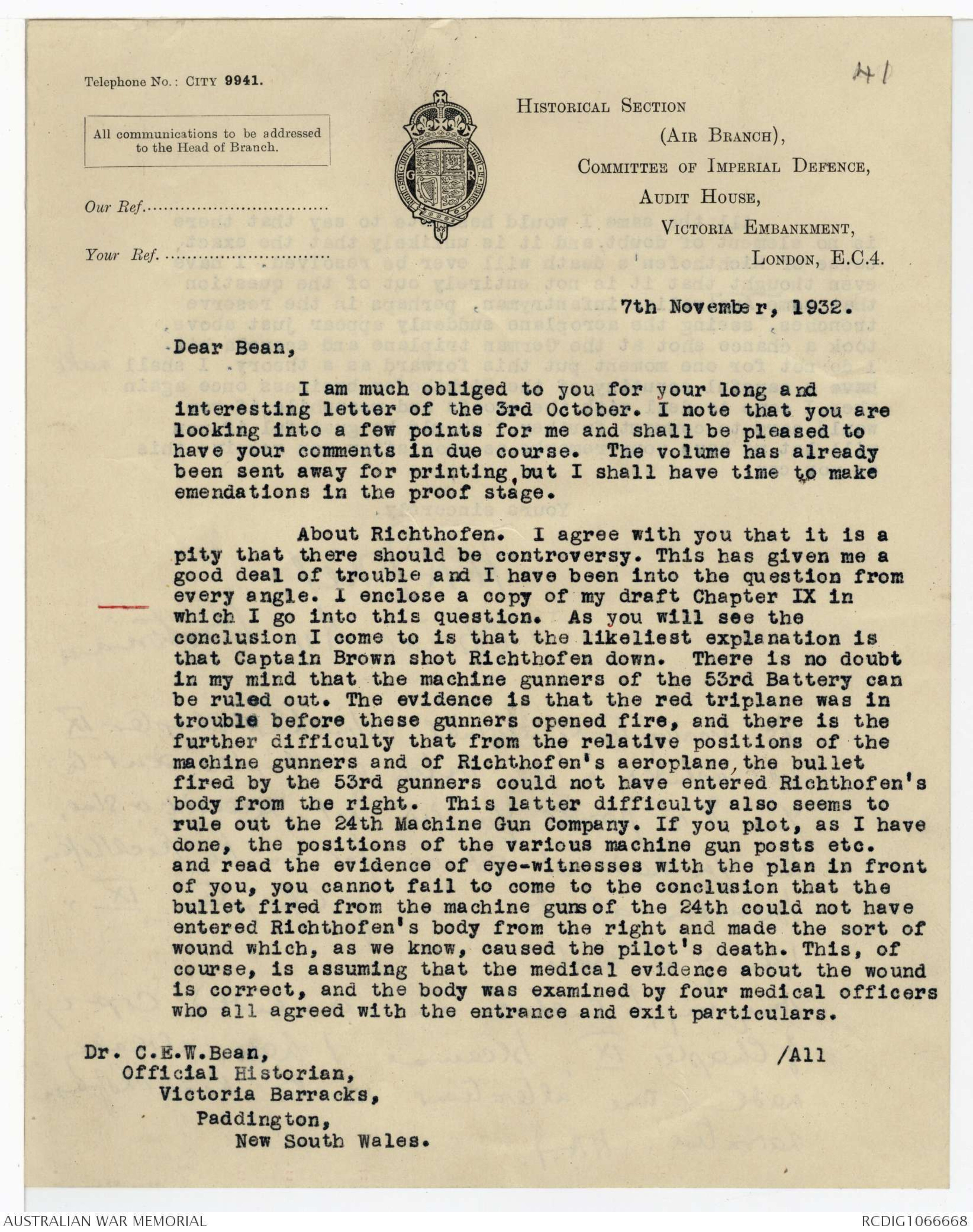

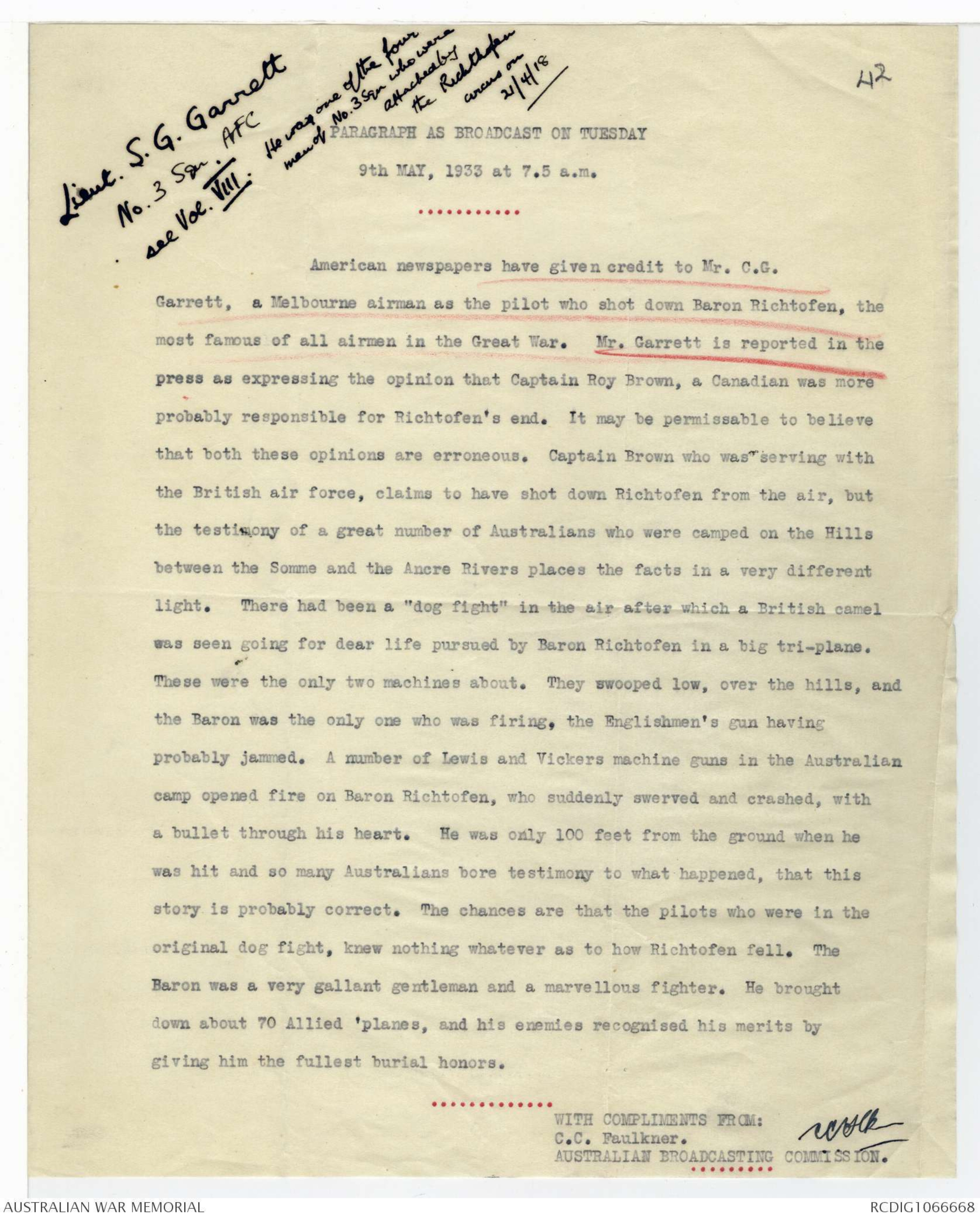
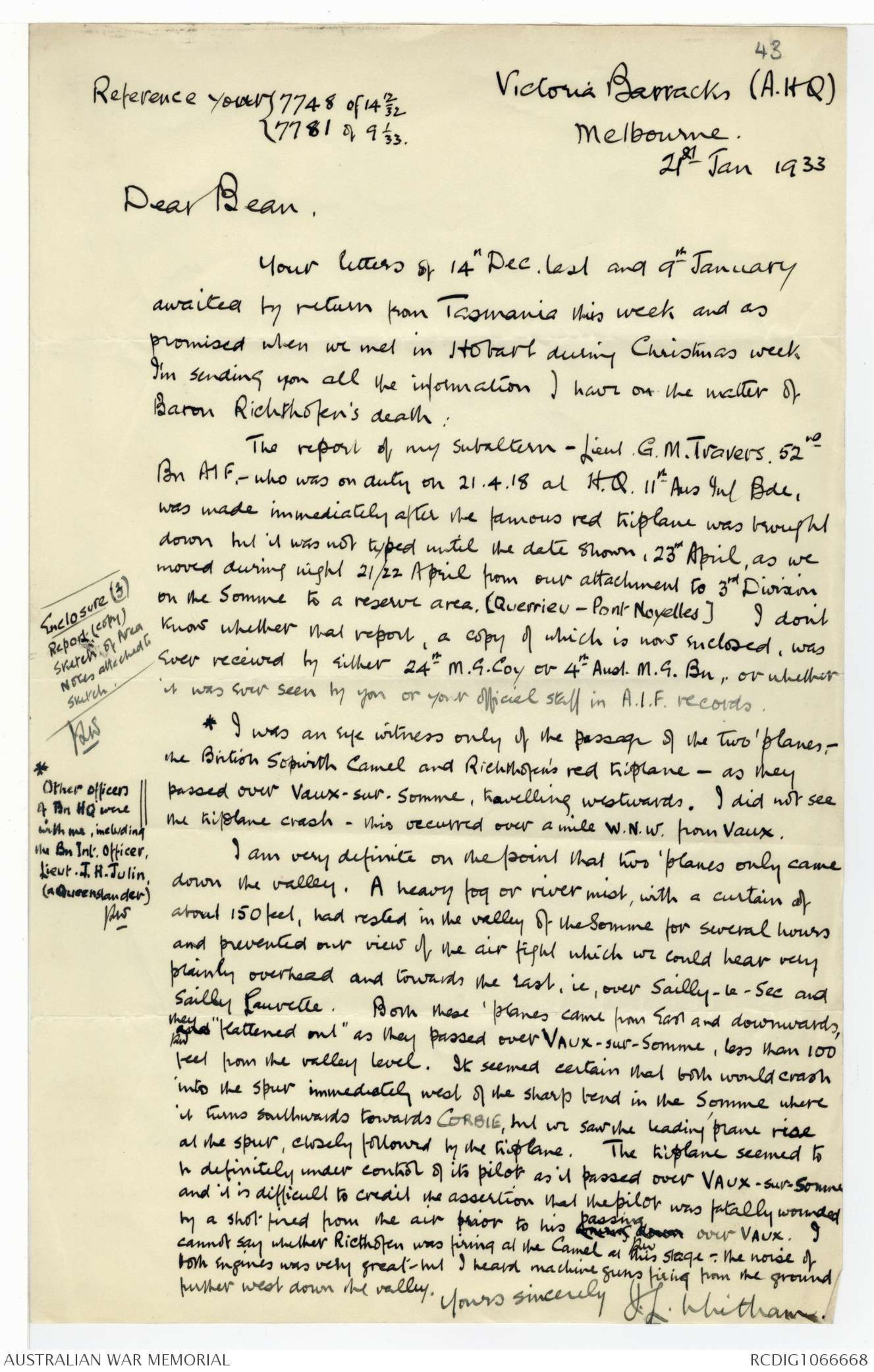
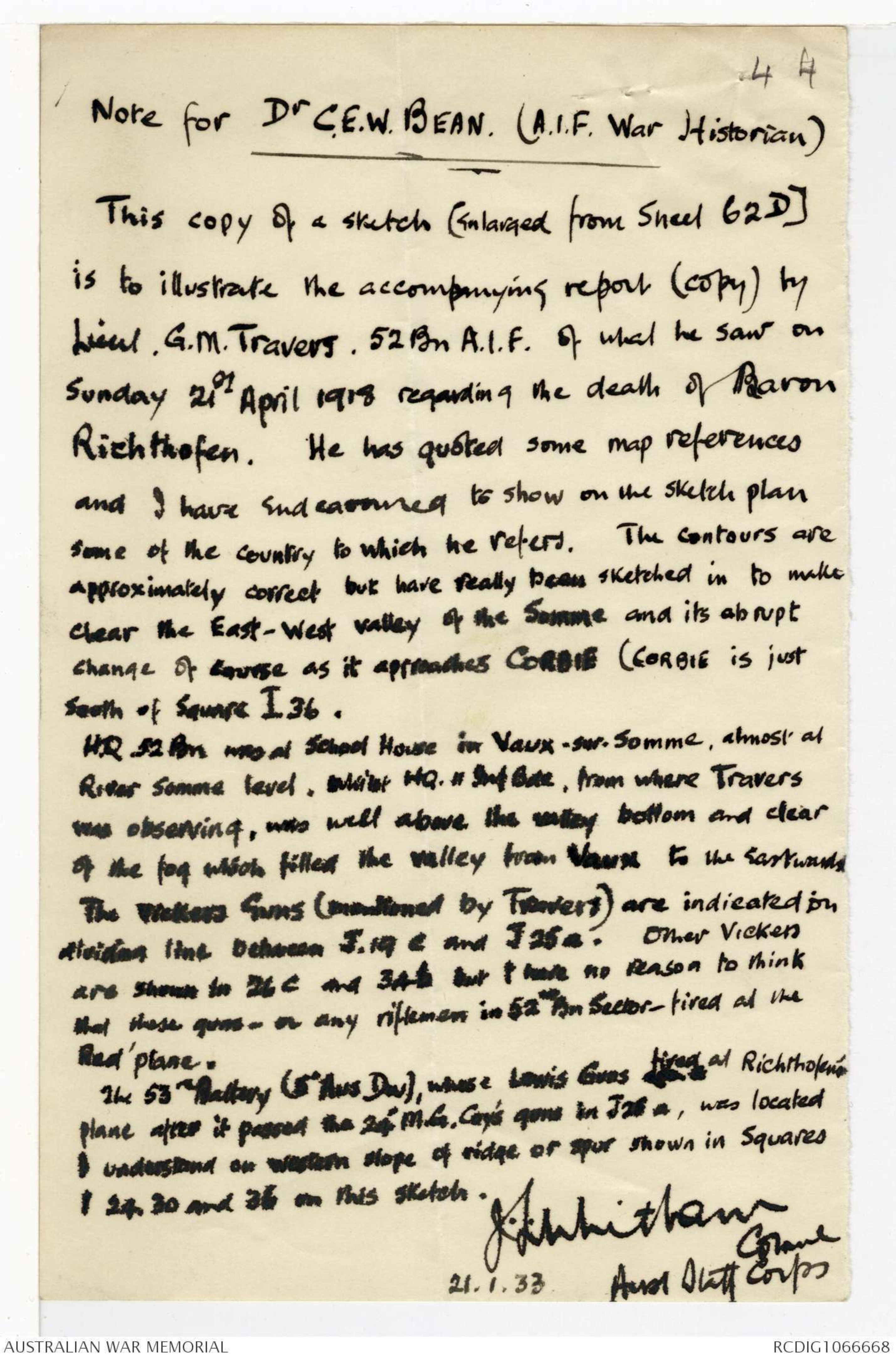
37b
3 . .
A report from the Official Correspondent to the Australian
Force during the War, states that after No. 209 Squadron had
thus celebrated this most glorious deed, the Australians put
their claim before the Headquarters of the R.A.F and General
Salmond stated that "while the R.A.F. could not relinquish
their claim they were prepared to share it with the
Australians."
The matter appears to have been honourably disposed of
right back in 1918 by this very fair agreement of General
Salmond. But as long as any of the combatants who took part
in the incident live, the fire of controversy will
periodically blaze us.
The accounts of the medical evidence of the number of
wounds Richthofen sustained and the position of the wounds
varies so greatly that it is difficult to form any opinion from
them as to whether the fatal shot came from the air or from
the ground.
I always maintained that the German Official Communique —
which appeared about a week after the incident, immediately
after the British Official Commmunique in the Daily Press —
was correct, and that the British statement that Richthofen
was brought down from the air was wrong; because of the low
altitude at which Lieut. May and Richthofen were flying and
because of the sudden burst of machine gun fire from the ground
when May decoyed Richthofen from nearly 200 feet above the
Somme level to about 30 feet above the high-lying Bray-Corbie
road. The German Communique said "He was brought down by
gun-fire from the ground"; and in commenting upon the British
Communique to the effect that the aeroplanes brought him down,
the German version of the affair asked, "How could this be,
for at the time of his death Richthofen was chasing the British
Airman?". And I saw this and made an entry in the Log to
the effect that a "British aeroplane followed by (?) hostile
triplane (red) passed over J.19.c at approx. 200 feet." Time 10.50. a.m.
One very significant fact has recently caught my eye: I
have been reading "War Birds (The Diary of a Unknown Aviator)" —
an American who joined the British Air Force. The Diarist makes
four references to Von Richthofen, two of which I give below :-
June 4th, 1918: "They say 'Archie' (referring to anti-aircraft
guns) is the most useless thing in the war, but
that Machine-Gun-Fire from the ground is greatly to be
feared. That's what got Richthofen:.
Again :-
37c
4 . .
July 20th, 1918: "Mannock got hit by Machine-Gun-Fire
from the ground, just like Richthofen".
These two statements from the Diary of an Airman of the
British Air Force point to the fact that at any rate some
members of the R.A.F. believed that Germany's greatest Air
Fighter was shot from the ground.
With regard to the anxiety of the family of Captain
Baron Von Richthofen over the recent ^a report that Captain A.E.
[*DJJ 4/6/36.*] Woodbridge shot down their gallant relation, the newspaper
cutting I have before me states (referring to the late
Captain Woodbridge) : "In June 1917 he shot down the German
"Ace" Richthofen". If this refers to Richthofen's death,
it is wrong so far as the date is concerned, for the correct
date is "April 21st, 1918". If, however, Richthofen was
ever "shot down" before, it may have been Capt. A.E.Woodbridge
who did it. I have never before see Capt. Woodbridge's
name connected with the great historic incident of April 21st
1918, — the death of Manfred Von Richthofen.
I am, Sir,
Yours &c.,
Donald. J. Jenkins.
Late 2nd Lieut.
212 Siege Battery.
R.G.A.
55 Temple Road
Birmingham.
38
9431.
14 October 1935.
The Australian Trade Commissioner,
36 Yonge Street
Toronto, Canada.
Dear Sir,
I have shortly to deal in the Australian Official
History with the air fight in which the famous German ace,
Richthofen, met his death. I understand that in a museum in
Canada there is the seat of Richthofen's aeroplane, and that
it shows a bullet hole through the back. As the existence of
this bullet hole and its position and direction may have a
bearing on the manner in which he met his death, I should be
grateful if you could inquire for me as to these facts. I
would be glad to have the evidence of someone of sufficient
experience to be able definitely to recognise a bullet hole,
and also to have a sketch or photograph showing the direction
taken by the bullet. A sketch would perhaps be preferable.
Yours faithfully,
C.E.W. Bean
Official Historian.
39
Per "Aorangi" via Vancouver
closing Toronto November 29th.
COMMONWEALTH OF AUSTRALIA
OFFICE OF THE
AUSTRALIAN TRADE COMMISSIONER
IN CANADA
TELEGRAPHIC ADDRESS
"AUSTRADE"
TELEPHONE WAVERLEY 4460
15 KING STREET WEST
TORONTO 2, CANADA
November 27, 1935.
Capt. C.E.W. Bean,
Official Historian,
Commonwealth of Australia
Victoria Barracks,
Paddington, N.S.W.
Dear Capt. Bean:
I am in receipt of your letter of the 14th October relative to your
investigations concerning the death of the famous German ace,
Richthofen.
So far as can be ascertained the only part of Richthofen's aeroplane
which is stored in Canada is the seat. This seat is at present on
exhibition in the Canadian Military Institute, Toronto,and has been
seen by Mr. Ellen, my Assistant. There are several holes on the back
of the seat but these are of such uniform character as to indicate
that they are small nail holes. There is one jagged hole at the right-hand
lower side towards the front. The aeroplane was, however, for
some time in an exposed position in the museum and some parts were
taken by sight-seers as souvenirs. It seems, therefore, that at this
stage it is impossible for anyone to say whether the hole in question
was caused by a bullet.
Captain Roy Brown, the Canadian viator who chased Richthofen out of
the air fight, ^when the latter pursued Captain May, resides in Toronto and I have had the pleasure of an
interview with him. He states that he is not prepared to enter into
any further controversy. He suggests that you should refer to the
British Official History based on the evidence, including the postmortem
report, presented to the court of enquiry after Richthofen's
death. Captain Brown confirmed the information that the holes in the
back of the aeroplane seat at the Military Institute were merely nail
punches. In his opinion also the larger hole in the right-hand lower
portion was not a bullet hole.
Captain Brown did indicate quite privately that he understood the postmortem
of Baron Richthofen showed that the bullet had entered his right
shoulder and travelled downwards through the heart.
It seems that the aeroplane seat in the Military Institute is of no
value as evidence, and that perusal of the official documents held by
the British authorities relating to the court of enquiry and postmortem
examination would be the most valuable source of reference.
I attach a copy of the original inscription in the case containing the
aeroplane seat at the Mililtary Institute, Toronto.
Your very truly,
L R Macgregor
(L.R. Macgregor)
AUSTRALIAN TRADE COMMMISSIONER IN CANADA.
E:S
40
CANADIAN MILITARY INSTITUTE
Copy of the inscription in the case of the Foker triplane
deposited on the Canadian Military Institute
by Captain Roy Brown, D.S.C.
_____________________
"This case contains the seat of the Foker triplane of Baron
M.Von Richtofen regarded as the most distinguished of the German airmen
in the Great War,having 82 Allied planes to his credit. He was shot
through the heart by Captain Roy Brown,D.S.C., and bar,Royal Air Force,
of Carleton Place,Ont., in an air engagement over the Somme Valley,
21st.April,1918. Captain Brown was flying after Richtofen,and while
slightly above and behind him on his left rear brought him down by
the shot mentioned.
When the German triplane reached the earth,a claim was made by
the crew of a machine gun, and also by an anti-aircraft battery, that
had fired the shot which ended the career of Richtofen. These claims,
and the statement of Captain Brown were enquired into by a Board,and
the evidence adduced by those firing being somewhat conflicting,the
evidence of the surgeon who examined the dead and gallant airman,
proved that the course of the bullet through the body showed that it
could only have been fired from an aeroplane in the position of
Captain Brown,and a finding was made accordingly.
Captain Brown having been given this trophy and memento,has
kindly deposited it in the Museum of the Canadian Military Institute.
It will be a reminder to Canadians of the prowess of one of them in
the air."
41
Telephone No.: CITY 9941.
All communications to be addressed
to the Head of Branch.
Our Ref.................................
Your Ref...............................
HISTORICAL SECTION
(AIR BRANCH),
COMMITTEE OF IMPERIAL DEFENCE,
AUDIT HOUSE
VICTORIA EMBANKMENT,
LONDON, E.C.4.
7th November, 1932.
Dear Bean,
I am much obliged to you for your long and
interesting letter of the 3rd October. I note that you are
looking into a few points for me and shall be pleased to
have your comments in due course. The volume has already
been sent away for printing, but I shall have time to make
emendations in the proof stage.
About Richthofen. I agree with you that it is a
pity that there should be a controversy. This has given me a
good deal of trouble and I have been into the question from
every angle. I enclose a copy of my draft Chapter IX in
[*—*] which I go into this question. As you will see
the conclusion I come to is that the likeliest explanation is
that Captain Brown shot Richthofen down. There is no doubt
in my mind that the machine gunners of the 53rd Battery can
be ruled out. The evidence is that the red triplane was in
trouble before these gunners opened fire, and there is the
further difficulty that from the relative positions of the
machine gunners and of Richthofen's aeroplane, the bullet
fired by the 53rd gunners could not have entered Richthofen's
body from the right. This latter difficulty also seems to
rule out the 24th Machine Gun Company. If you plot, as I have
done, the positions of the various machine gun posts etc.
and read the evidence of eye-witnesses with the plan in front
of you, you cannot fail to come to the conclusions that the
bullet fired from the machine guns of the 24th could not have
entered Richthofen's body from the right and made the sort of
would which, as we know, caused the pilot's death. This, of
course, is assuming that the medical evidence about the wound
is correct, and the body was examined by four medical officers
who all agreed with the entrance and exit particulars.
Dr. C.E.W. Bean
Official Historian,
Victoria Barracks,
Paddington,
New South Wales.
/A11
All the same I would hesitate to say that there
is no element of doubt, and it is unlikely that the exact
cause of Richthofen's death will ever be resolved. I have
even thought that it is not entirely out of the question
that some ^unknown Australian Infantryman, perhaps in the reserve
trenches, seeing the aeroplane suddenly appear just above,
took a chance shot at the German triplane and scored a hit.
I do not for one moment put this forward as a theory. I shall makexxx a careful scrutiny of the Richthofen business once again
when I come to deal with the proofs and, meanwhile, if you
would care to comment further I should be grateful if you
will let me have your remarks as soon after you receive this
as you can.
Yours sincerely,
H A Jones
Official Air Historian
PS. According to my original instructions, Chapter IX
was included in the batch of chapters sent to
you. It is possible you did not receive it or else,
that you had not got as far as the Richthofen
business, at the end of Chapter IX,
when you wrote.
Anyway, I enclose an amended copy
of Chapter IX, because I have already
made some alterations in the Richthofen
narrative.
H.A.J.
42
Lieut. S.G. Garrett
No. 3 Sqn. AFC
see Vol. VIII. He was one of the four
men of No. 3 Sqn who were
attacked by
the Richthofen
circus on
21/4/18
PARAGRAPH AS BROADCAST ON TUESDAY
9th MAY, 1933 at 7.5 a.m.
. . . . . . . . . . . . . . . .
American newspapers have give credit to Mr. C.G
Garrett, a Melbourne airman as the pilot who shot down Baron Richtofen, the
most famous of all airmen in the Great Wat. Mr Garrett is reported in the
press as expressing the opinion that Captain Roy Brown, a Canadian was more
probably responsible for Richtofen's end. It may be permissable to believe
that both these opinions are erroneous. Captain Brown who was serving with
the British air force, claims to have shot down Richtofen from the air, but
the testimony of a great number of Australians who were camped on the Hills
between the Somme and the Ancre Rivers places the facts in a very different
light. There had been a "dog fight" in the air after which a British camel
was seen going for dear life pursued by Baron Richtofen in a big tri-plane.
These were the only two machines about. They swooped low, over the hills, and
the Baron was the only one who was firing, the Englishmen's gun having
probably jammed. A number of Lewis and Vickers machine guns in the Australian
camp opened fire on Baron Richtofen, who suddenly swerved and crashed, with
a bullet through his heart. He was only 100 feet from the ground when he
was hit and so many Australians bore testimony to what happened, that this
story is probably correct. The chances are that the pilots who were in the
original dog fight, knew nothing whatever as to how Richtofen fell. The
Baron was a very gallant gentleman and a marvellous fighter. He brought
down about 70 Allied 'planes, and his enemies recognised his merits by
giving him the fullest burial honors.
. . . . . . . . .
WITH COMPLIMENTS FROM:
C.C. Faulkner
AUSTRALIAN BROADCASTING COMMMISSION.
43
Victoria Barracks (A.HQ)
Melbourne.
21st Jan 1933
Reference your {7748 of 14 12/32
{7781 of 9 1/33.
Dear Bean.
Your letter of 14th Dec. last and 9th January
awaited by return from Tasmania this week and as
promised when we met in Hobart during Christmas week
I'm sending you all the information I have on the matter of
Baron Richthofen's death.
The report of my subaltern - Lieut G.M. Travers. 52nd
Bn AIF. - who was on duty on 21.4.18 at H.Q. 11th Aus Inf Bde,
was made immediately after the famous red triplane was brought
down but it was not typed until the date shown, 23rd April, as we
moved during night of 21/22 April from our attachment to 3rd Division
on the Somme to a reserve area. (Querrieu - Pont Noyelles] I don't
[*Enclosure (3)
Report (copy)
sketch of Area
Notes attached to
sketch.*]
JLW
know whether that report, a copy of which is now enclosed, was
ever received by either 24th M.G. Coy or 4th Aust. M.G. Bn,. or whether
it was ever seen by you or your official staff in A.I.F. records.
* I was an eye witness only of the passage of the two 'planes.-
the British Sopwith Camel and Richthofen's red triplane - as they
passed over Vaux-sur-Somme, travelling westwards. I did not see
the triplane crash - this occurred over a mile W.N.W. from Vaux.
[**Other officers
of Bn HQ were
with me, including
the Bn Int. Officer
Lieut. J.R.Julin,
(a Queenslander)
JLW*]
I am very definite on the point that two 'planes only came
down the valley. A heavy fog or river mist, with a curtain of
about 150 feet, had rested in the valley of the Somme for several hours
and prevented our view of the air fight which we could hear very
plainly overhead and towards the East, ie, over Sailly–le–Sec and
Sailly Laurette. Both these 'planes came from East and downwards,
they and flew "Kattened out" as they passed over VAUX-sur-Somme, less than 100
feet from the valley level. It seemed certain that both would crash
into the spur immediately west of the sharp bend in the Somme where
it turns southwards towards CORBIE, but we saw the leading 'plane rise
at the spur, closely followed by the triplane. The triplane seemed to
be definitely under control of its pilot as it passed over VAUX-sur-Somme
and it is difficult to credit the assertion that the pilot was fatally wounded
by a shot fired from the air prior to his coming down passing over VAUX. I
cannot say whether Ricthofen was firing at the Camel at this stage - the noise of
both engines was very great - but I heard machine guns firing from the ground
further west down the valley.
Yours sincerely
J.L. Whitlam.
44
Note for Dr C.E.W. BEAN. (A.I.F. War Historian)
This copy of a sketch [enlarged from Sheet 62D]
is to illustrate the accompanying report (copy) by
Lieut. G.M. Travers. 52 Bn A.I.F. of what he saw on
Sunday 21st April 1918 regarding the death of Baron
Richthofen. He was quoted some map references
and I have endeavored to show on the sketch plan
some of the country to which he refers. The contours are
approximately correct but have really been sketched in to make
clear the East-West valley of the Somme and its abrupt
change of course as it approaches CORBIE (CORBIE is just
south of Square I36.
H.Q 32 Bn was at School House in VAUX-sur-Somme, almost at
River Somme level. [[assist?]] HQ. & Inf Bde, from where Travers
was observing, was well above the valley bottom and clear
of the fog which filled the valley from Vaux to the Eastwards
The Vickers Guns (mentioned by Travers) are indicated on
divided line between J.19c and J25a. Others Vickers
are shown in 21 c and 3A[[?]] but I note no reason to think
that those guns - on any rifleman in 52nd Bn Sector - fired at the
Red 'plane.
The 53rd Battery (5th Aus Div), whose Lewis Guns xxxx xx fired at Richthofen's
plane after it passed the 24th M.G. Coy's guns in J25a, was located
I understand on western slope of ridge or spur shown in Squares
I 24 30 and 36 on this sketch.
J.L. Whitlam
Colonel
Aust Staff Corps
21.1.33.
 Sam scott
Sam scottThis transcription item is now locked to you for editing. To release the lock either Save your changes or Cancel.
This lock will be automatically released after 60 minutes of inactivity.